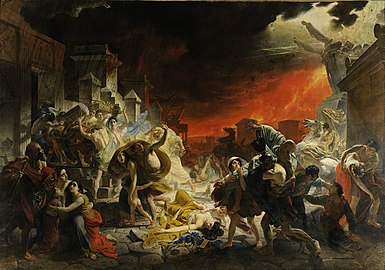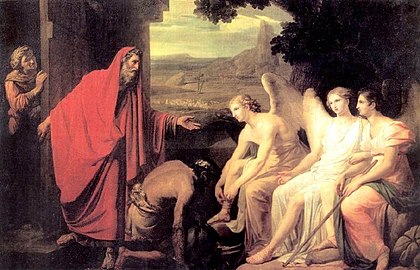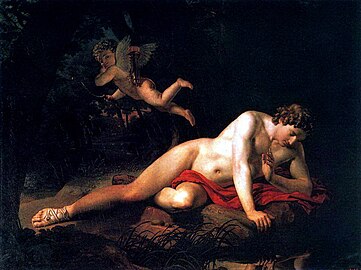Karl Bryullov
Karl Bryullov | |
|---|---|
| Карл Брюллов | |
Cimitero Acattolico | |
| Education | Professor by rank (1836) |
| Alma mater | Imperial Academy of Arts (1821) |
| Known for | Engraving, Painting |
| Movement | Romantic |
| Awards | |
Karl Pavlovich Bryullov, also Briullov or Briuloff, born Charles Bruleau[1][2] (Russian: Карл Па́влович Брюлло́в; 23 December [O.S. 12 December] 1799 – 23 Jule [O.S. 11 June] 1852) was a Russian painter. He is regarded as a key figure in transition from the Russian neoclassicism to romanticism.
Biography
Karl Bryullov was born on 12 (23) December 1799 in
His best-known work,
An anecdote concerning Bryullov appeared in Leo Tolstoy's essay "Why Do Men Stupefy Themselves?" and later in the same author's book What Is Art?.
While teaching at the academy (1836–1848) he developed a portrait style which combined a
Characteristics of art
Bryullov's work is the pinnacle of late Russian Romanticism when the sense of harmonic wholeness and beauty of the world is replaced by a feeling of tragedy and conflict of life. In the forefront of the historical picture, but its main theme - not the struggle of heroes, as in classicism, and the fate of the huge human masses. In his central work "The Last Day of Pompeii" Bryullov combined the drama of action, romantic lighting effects and sculptural plasticity of figures. The painting brought the artist great fame both in Russia and in Europe.
An outstanding master of both ceremonial and chamber portraits, Bryullov evolved in his art from the joyful embrace of life in his early works to the intricate psychologism of his later ones, thus anticipating the achievements of such artists like Ilya Repin in the second half of the 19th century. Bryullov had an enormous influence on Russian artists, among whom he had many followers and imitators.[4]
Selected artwork
-
Narcissus, 1819, Russian Museum
-
A Dream of a Girl Before a Sunrise, 1830-1833, Pushkin Museum
-
Italian Morning, 1823, Kunsthalle Kiel
-
Italian Midday, 1827, Russian Museum
-
Bathsheba, 1832, Tretyakov Gallery
-
Girl, gathering grapes in the vicinity of Naples, 1827, Russian Museum
-
Fortuneteller Svetlana, 1836, Nizhny Novgorod State Art Museum
-
Portrait of Sophia Andreevna Bobrinskaya (Shuvalova), 1849, Hermitage Museum
-
Portrait of fabulist Ivan Andreyevich Krylov , 1839, Tretyakov Gallery
-
Portrait of Countess Julia Pavlovna Samoilova moving away from the ball with her adopted daughter Amazilia Pacini (Masquerade). Not later than 1842. Russian Museum
See also
References and notes
- ^ Karl Pavlovich Bryullov at the Encyclopædia Britannica
- ^ Agnieszka Świętosławska (2015). "Emigration as an artistic turning point – Ignacy Szczedrowski, Konstanty Kukiewicz and Tadeusz Gorecki at the Imperial Academy of Arts in Saint Petersburg". Art Inquiry (17). Łódzkie Towarzystwo Naukowe: 321–345.
- ^ Karl Pavlovich Bryullov at the Encyclopædia Britannica
- OCLC 44796988.
Literature
- С. Н. Кондаков (1915). Юбилейный справочник Императорской Академии художеств. 1764-1914 (in Russian). Vol. 2. p. 25.
External links
- Paintings by Bryullov Karl - high res
- Online gallery of Briullov paintings
- Brullov's paintings at the Russian Art Gallery
- Karl Brulloff. The Last Day of Pompeii














